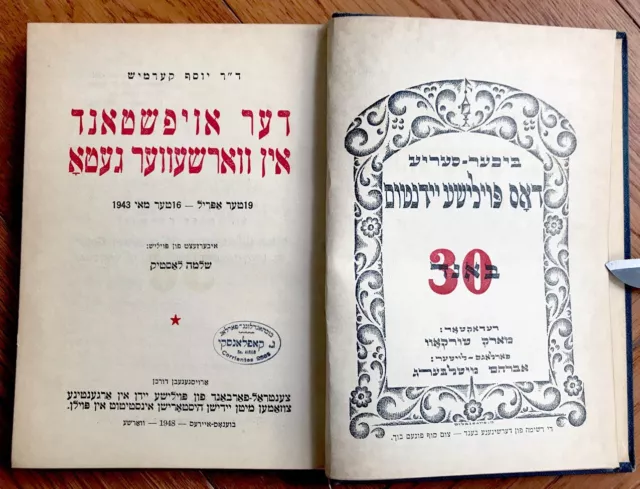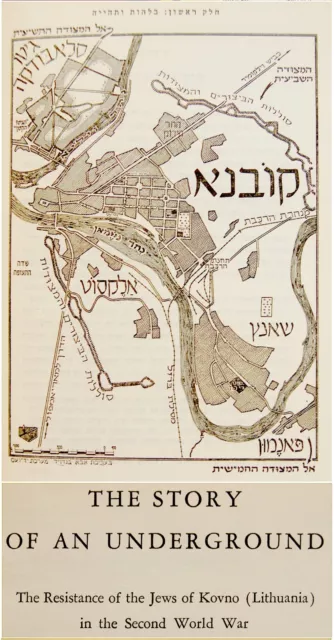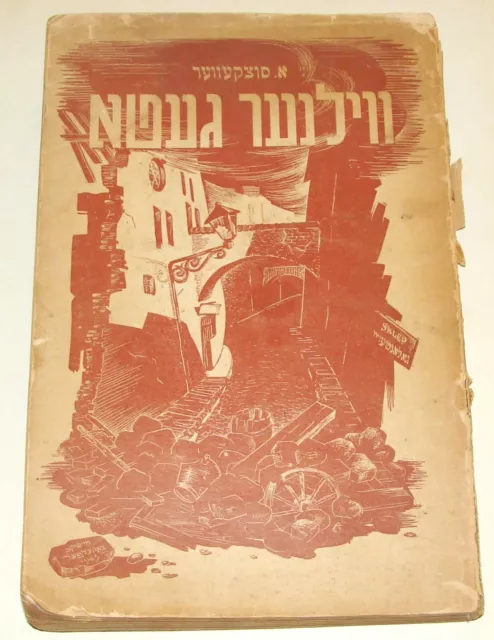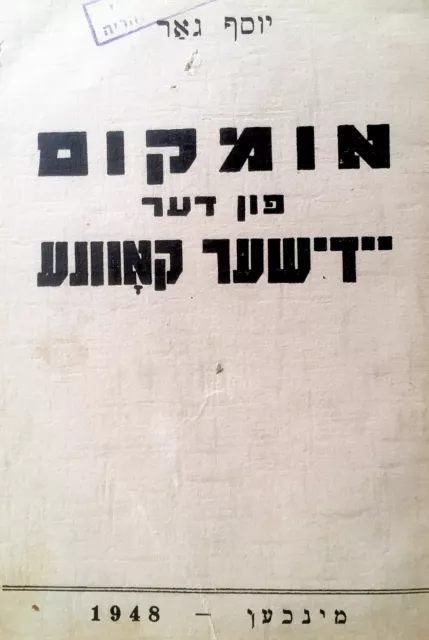1948 Jewish KOVNO GHETTO Yizkor YIDDISH BOOK Holocaust PHOTOS MAPS DOCUMENTS
PAYMENTS : Payment method accepted : Paypal & All credit cards.
SHIPPMENT : Shipp worldwide via registered airmail is $ 25 . Book will be sent inside a protective packaging . Handling around 5-10 days after payment.
The Kovno ghetto was a ghetto established by Nazi Germany to hold the Lithuanian Jews of Kaunas during the Holocaust. At its peak, the Ghetto held 40,000 people, most of whom were later sent to concentration and extermination camps, or were shot at the Ninth Fort. About 500 Jews escaped from work details and directly from the Ghetto, and joined Soviet partisan forces in the distant forests of southeast Lithuania and Belarus.The Nazis established a civilian administration under SA Major General Hans Kramer to replace military rule in place from the invasion of Lithuania on June 22, 1941. The Lithuanian Provisional Government was officially disbanded by the Nazis after only a few weeks, but not before approval for the establishment of a ghetto under the supervision of Lithuanian military commandant of Kaunas Jurgis Bobelis, extensive laws enacted against Jews and the provision of auxiliary police to assist the Nazis in the genocide. Between July and August 15, 1941, the Germans concentrated Jews who survived the initial pogroms, some 29,000 people, in a ghetto established in Vilijampolė (Slabodka). It was an area of small primitive houses and no running water which had been cleared of its mainly Jewish population in pogroms by Lithuanian activists beginning on June 24.The ghetto had two parts, called the "small" and "large" ghetto, separated by Paneriai Street and connected by a small wooden bridge over the street. Each ghetto was enclosed by barbed wire and closely guarded. Both were overcrowded, with each person allocated less than ten square feet of living space. The Germans continually reduced the ghetto's size, forcing Jews to relocate several times. The Germans and Lithuanians destroyed the small ghetto on October 4, 1941, and killed almost all of its inhabitants at the Ninth Fort. Later that same month, on October 29, 1941, the Germans staged what became known as the "Great Action." In a single day, they shot around 10,000 Jews at the Ninth Fort.The ghetto in Kovno provided forced labor for the German military. Jews were employed primarily as forced laborers at various sites outside the ghetto, especially in the construction of a military airbase in Aleksotas. The Jewish council (Aeltestenrat; Council of Elders), headed by Dr. Elkhanan Elkes, also created workshops inside the ghetto for those women, children, and elderly who could not participate in the labor brigades. Eventually, these workshops employed almost 6,500 people. The council hoped the Germans would not kill Jews who were producing for the army.The Underground SchoolAs an act of defiance an underground school was conducted in the Kovno Ghetto when such education was banned in 1942. A remarkable photo of one of the classes of that school features in the US Holocaust publication, "The Hidden History of the Kovno Ghetto". Identification of the teacher visible in that photo is given in a website that deals with the hidden school.[1] However almost all of the children in the Ghetto, approximately 2,500, were removed in the Kinder Aktion of 27–28 March 1944.Smuggling Babies out of the GhettoFrom 1942 births were not permitted in the ghetto and pregnant women faced death. However a number of babies of ages from about 9 months to 15 months were smuggled out of the Kovno Ghetto to willing Lithuanian foster mothers.[2]Final daysIn the autumn of 1943, the SS assumed control of the ghetto and converted it into the Kovno concentration camp. The Jewish council's role was drastically curtailed. The Nazis dispersed more than 3,500 Jews to subcamps where strict discipline governed all aspects of daily life. On October 26, 1943, the SS deported more than 2,700 people from the main camp. The SS sent those deemed fit to work to Vaivara concentration camp in Estonia, and deported surviving children and the elderly to Auschwitz.On July 8, 1944, the Germans evacuated the camp, deporting most of the remaining Jews to the Dachau concentration camp in Germany or to the Stutthof camp, near Danzig, on the Baltic coast. Three weeks before the Soviet army arrived in Kovno, the Germans razed the ghetto to the ground with grenades and dynamite. As many as 2,000 people burned to death or were shot while trying to escape the burning ghetto. The Red Army occupied Kovno on August 1, 1944. Of Kovno's few Jewish survivors, 500 had survived in forests or in a single bunker which had escaped detection during the final liquidation; the Germans evacuated an additional 2,500 to concentration camps in Germany.ResistanceThroughout the years of hardship and horror, the Jewish community in Kovno documented its story in secret archives, diaries, drawings and photographs. Many of these artifacts lay buried in the ground when the ghetto was destroyed. Discovered after the war, these few written remnants of a once thriving community provide evidence of the Jewish community's defiance, oppression, resistance, and death. George Kadish (Hirsh Kadushin), for example, secretly photographed the trials of daily life within the ghetto with a hidden camera through the buttonhole of his overcoat.The Kovno ghetto had several Jewish resistance groups. The resistance acquired arms, developed secret training areas in the ghetto, and established contact with Soviet partisans in the forests around Kovno.In 1943, the General Jewish Fighting Organization (Yidishe Algemeyne Kamfs Organizatsye) was established, uniting the major resistance groups in the ghetto. Under this organization's direction, some 300 ghetto fighters escaped from the Kovno ghetto to join Jewish partisan groups. About 70 died in action.The Jewish council in Kovno actively supported the ghetto underground. Moreover, a number of the ghetto's Jewish police participated in resistance activities. The Germans executed 34 members of the Jewish police for refusing to reveal specially constructed hiding places used by Jews in the ghetto.Notable prisoners Aharon Barak Zev Birger Kama Ginkas George Kadish Avraham Duber Kahana Shapiro Ephraim Oshry Abe Rich and Family Sidney Shachnow Aleksandras Štromas The Holocaust in Nazi-occupied Lithuania resulted in the near total destruction of Lithuanian Jews[a] living in the Nazi-controlled Lithuanian and Polish territories (Generalbezirk Litauen of Reichskommissariat Ostland). Out of approximately 208,000 to 210,000 Jews, an estimated 190,000–195,000 were murdered before the end of World War II (wider estimates are sometimes published); most between June and December 1941.[1][2][3] The Holocaust resulted in the largest ever loss of life in so short a space of time in the history of Lithuania.[3]The events that took place in the western regions of the USSR occupied by Nazi Germany in the first weeks after the German invasion, including Lithuania, marked the sharp intensification of the Holocaust.[4][5][6][b]An important component to the Holocaust in Lithuania was that the occupying Nazi German administration fanned antisemitism by blaming the Soviet regime's recent annexation of Lithuania, a year earlier, on the Jewish community. Another significant factor was the large extent to which the Nazis' design drew upon the physical organization, preparation and execution of their orders by local Lithuanian auxiliaries of the Nazi occupation regime.[1][2]BackgroundFor more details on this topic, see History of the Jews in Lithuania.occupation which had culminated in mass deportations across the Baltics only a week before the invasion. The Germans were welcomed as liberators and received support from Lithuania's irregular militia against retreating Soviet forces. Many Lithuanians believed Germany would allow the re-establishment of the country's independence.[7] In order to appease the Germans, some people expressed significant antisemitic sentiments.[8] Nazi Germany, which had seized the Lithuanian territories in the first week of the offensive, used this situation to its advantage and indeed in the first days permitted a Lithuanian Provisional Government of the Lithuanian Activist Front to be established.[7] For a brief period it appeared that the Germans were about to grant Lithuania significant autonomy, comparable with that given to Slovak Republic.[7] However, after about a month, the more independently minded Lithuanian organizations were disbanded around August and September 1941, as the Germans seized more control.[7]The destruction of Lithuanian JewryPrior to the German invasion, the population of Jews was estimated to be about 210,000,[2] although according to data from the Lithuanian statistics department, as of 1 January 1941 there were 208,000 Jews.[3] This estimate, based on the officially accounted for prewar emigration within the USSR (approx. 8,500), the number of escapees from Kaunas and Vilnius Ghettos, (1,500-2,000), as well as the number of the survivors in the concentration camps when they were liberated by the Red Army, (2,000-3,000), puts the number of Lithuanian Jews murdered in the Holocaust at 195,000 to 196,000.[3] It is difficult to estimate the exact number of casualties of the Holocaust and the latter number cannot be final or indisputable. The numbers given by historians differ significantly ranging from 165,000 to 254,000, the higher number probably including non-Lithuanian Jews among other Riech (empirical) dissenters labeled as Jewish killed in Lithuania.[3]The Holocaust eventsChronologically, the genocide in Lithuania can be divided into three phases: phase 1) summer to the end of 1941; phase 2) December 1941 – March 1943; phase 3) April 1943 – mid-July 1944.[9]The Lithuanian port city of Klaipėda (Memel in German) had historically been a member of the German Hanseatic League, and had belonged to Germany and East Prussia prior to 1918. The city was semi-autonomous during the period of Lithuanian independence, and under League of Nations supervision. Approximately 8,000 Jews lived in Memel when it was absorbed into the Reich on March 15, 1939. Its Jewish residents were expelled, and most fled into Lithuania proper. In 1941, German killing squads, the Einsatzgruppen, followed the advance of the German army units and immediately began organizing the murder of Jews.[5] Most Lithuanian Jews perished in the first phase during the first months of the occupation and before the end of 1941. The first recorded action of the Einsatzgruppen (Einsatzgruppe A) took place on June 22, 1941, in the border town of Gargzdai (called Gorzdt in Yiddish and Garsden in German), which was one of the oldest Jewish settlements in the country and only eleven miles from German-annexed Memel. Approximately 800 Jews were shot that day in what is known as the Garsden Massacre. Approximately 100 non-Jewish Lithuanians were also executed, many for trying to aid their Jewish neighbors.[1][2] About 80,000 Jews were killed by October and about 175,000 by the end of the year.[1] The majority of Jews in Lithuania were not required to live in ghettos[c] nor sent to the Nazi concentration camps which at that time were just in the preliminary stages of operation. Instead they were shot in pits near their places of residence with the most infamous mass murders taking place in the Ninth Fort near Kaunas and the Ponary Forest near Vilnius.[5][10][11] By 1942 about 45,000 Jews survived, largely those who had been sent to ghettos and camps.[c] In the second phase, the Holocaust slowed, as Germans decided to use the Jews as forced labor to fuel the German war economy.[12] In the third phase, the destruction of Jews was again given a high priority; it was in that phase that the remaining ghettos and camps were liquidated.Two factors contributed to the rapid destruction of Lithuanian Jewry. The first was the significant support for the "de-Jewification" of Lithuania coming from the Lithuanian populace.[8][12] The second was the German plan for early colonization of Lithuania – which shared a border with German East Prussia – in accordance with their Generalplan Ost; hence the high priority given to the extermination of the relatively small Lithuanian Jewish community.[12] Participation of local collaborators The Nazi German administration directed and supported the organized killing of Lithuanian Jews. Local Lithuanian auxiliaries of the Nazi occupation regime carried out logistics for the preparation and execution of the murders under Nazi direction.[1][2][12] Nazi SS Brigadeführer Franz Walter Stahlecker arrived in Kaunas on 25 June 1941 and gave agitation speeches in the city to instigate the murder of Jews. Initially this was in the former State Security Department building, but officials there refused to take any action. Later, he gave speeches in the city.[13] In a report of October 15, Stahlecker wrote that they had succeeded in covering up their vanguard unit (Vorkommando) actions, and it was made to look like it was the initiative of the local population.[13][14] Groups of partisans, civil units of nationalist-rightist anti-Soviet affiliation, initiated contact with the Germans as soon as they entered the Lithuanian territories.[1] A rogue unit of insurgents headed by Algirdas Klimaitis and encouraged by Germans from the Sicherheitspolizei and Sicherheitsdienst, started anti-Jewish pogroms in Kaunas (Kovno) on the night of 25–26 June 1941. Over a thousand Jews perished over the next few days in what was the first pogrom in Nazi-occupied Lithuania.[5][14][15] Different sources give different figures, one being 1,500[5] and another 3,800, with additional victims in other towns of the region.[15]On 24 June 1941, the Lithuanian Security Police (Lietuvos saugumo policija), subordinate to Nazi Germany's Security Police and Nazi Germany's Criminal Police, was created. It would be involved in various actions against the Jews and other enemies of the Nazi regime.[14] Nazi commanders filed reports purporting the "zeal" of the Lithuanian police battalions surpassed their own.[8] The most notorious Lithuanian unit participating in the Holocaust was the Lithuanian Sonderkommando Squad (Ypatingasis būrys) from the Vilnius (Vilna, Wilno) area which[citation needed] killed tens of thousands of Jews, Poles and others in the Ponary massacre.[10][11][14] Another Lithuanian organization involved in the Holocaust was the Lithuanian Labor Guard.[1] Many Lithuanian supporters of the Nazi policies came from the fascist Iron Wolf organization.[2] Overall, the nationalistic Lithuanian administration was interested in the liquidation of the Jews as a perceived enemy and potential rivals of ethnic Lithuanians and thus not only did not oppose Nazi Holocaust policy but in effect adopted it as their own.[12]A combination of factors serves as an explanation for participation of some Lithuanians in genocide against Jews.[8] Those factors include national traditions and values, including antisemitism, common throughout contemporary Central Europe, and a more Lithuanian-specific desire for a "pure" Lithuanian nation-state with which the Jewish population was believed to be incompatible.[2] There were a number of additional factors, such as severe economic problems which led to the killing of Jews over personal property.[8] Finally the Jews were seen as having supported the Soviet regime in Lithuania during 1940–1941.[d][2][8][12] During the period leading up to the German invasion, the Jews were blamed by some for virtually every misfortune that had befallen Lithuania.[2][12]The involvement of the local population and institutions, in relatively high numbers, in the destruction of Lithuanian Jewry became a defining factor of the Holocaust in Lithuania.[1][2][12]Not all of the Lithuanian populace supported the killings.[16] Out of a population of close to 3,000,000 (80% of it ethnic Lithuanians),[17] a few thousands took an active part in the killings while many hundreds risked their lives sheltering the Jews.[8] Israel has recognized 723 Lithuanians as Righteous Among the Nations for risking their lives to save Jews during the Holocaust.[2][8][18][19] In addition, many members of the Polish minority in Lithuania also helped to shelter the Jews.[16] Lithuanians and Poles who risked their lives saving Jews were persecuted and often executed by the Nazis.[20]Comprehension and remembranceThe genocide in Lithuania is seen by some historians as one of the earliest large-scale implementations of the Final Solution, leading some scholars to express an opinion that the Holocaust began in Lithuania in the summer of 1941.[5][6]^ Other scholars say the Holocaust started in September 1939 with the onset of the Second World War,[21] or even earlier, on Kristallnacht in 1938,[22] or, according to the Jewish Virtual Library, when Hitler became Chancellor of Germany in 1933.The Soviet government, for political reasons, tried to minimize the unique suffering of the Jews.[23] In Lithuania and throughout the Soviet Union, memorials did not mention Jews in particular; instead they were built to commemorate the suffering of "local inhabitants".[23] People guilty of Nazi collaboration and crimes against Jews were not punished severely.[23]Since Lithuania regained independence from the Soviet Union in 1991, the debate over Lithuanian participation in the Holocaust has been fraught with difficulty. Modern Lithuanian nationalists stress anti-Soviet resistance, but some Lithuanian partisans, seen in Lithuania as heroes in the struggle against Soviet occupation. were also Nazi collaborators who had cooperated in the murder of Lithuanian Jewry.[24] The post-Soviet Lithuanian government has on a number of occasions stated a commitment to commemorating the Holocaust, combating antisemitism, and bringing Nazi-era war criminals to justice.[19] The National Conference on Soviet Jewry (NCSJ) have said "Lithuania has made slow but significant progress in the prosecution of suspected Lithuanian collaborators in the Nazi genocide".[19] Lithuania was the first of the newly independent post-Soviet states to legislate for the protection and marking of Holocaust-related sites.[19] In 1995, president of Lithuania Algirdas Brazauskas speaking before the Israeli Knesset, offered a public apology to the Jewish people for the Lithuanian participation in the Holocaust.[16] On 20 September 2001, to mark the 60th anniversary of the Holocaust in Lithuania, the Seimas (Lithuanian parliament) held a session during which Alfonsas Eidintas, the historian nominated as the Republic's next ambassador to Israel, delivered an address accounting for the annihilation of Lithuania's Jews.[25]There has been criticism that Lithuania is dragging its feet on the issue; in 2001 Dr. Efraim Zuroff, Director of the Simon Wiesenthal Center, criticized the Lithuanian government for its unwillingness to prosecute Lithuanians involved in the Holocaust.[26] In 2002 the Simon Wiesenthal Center declared its dissatisfaction with the Lithuanian government’s efforts and launched a controversial "Operation Last Chance" offering monetary rewards for evidence that leads to the prosecution of war criminals; this campaign has encountered much resistance in Lithuania and the other former Soviet bloc countries.[19] More recently, in 2008, the Simon Weisenthal Center which had initially ranked Lithuania high during on-going trials to bring Lithuanian war criminals to justice, noted, in its annual report, no progress and the lack of any real punishment by Lithuanian justice organs for Holocaust perpetrators.[27]There has been limited debate on the place of the Holocaust in Lithuanian national memory; historically Lithuanians have denied national participation in the Holocaust or labeled the Lithuanian participants in genocide as fringe extreme elements.[25][28] The memories of that time and the discussion of those events in Jewish and Lithuanian historiographies are quite different,[25] although Lithuanian historiography in the past two decades has improved, compared to the Soviet historiography, with the works of scholars such as Alfonsas Eidintas, Valentinas Brandišauskas and Arūnas Bubnys, among others, being positively reviewed by the Western and Jewish historians.[9][25][29] The issue remains controversial to this day.[25][29] According to Lithuanian historians, the contentious issues involve the role of the Lithuanian Activist Front, the Lithuanian Provisional Government and participation of Lithuanian civilians and volunteers in the Holocaust.[25] ebay5758/ 203
- Condition: Used
- Condition: Very good condition. EX kubrary copy with a few stamps. Tightly bound. Age tanning of pages. Slight cover wear . End content pp are very fragile and torn yet fully present. ( Please look at scan for actual AS IS images )
- Country of Manufacture: Israel
- Country/Region of Manufacture: Lithuania
- Religion: Judaism
PicClick Insights - 1948 Jewish KOVNO GHETTO Yizkor YIDDISH BOOK Holocaust PHOTOS MAPS DOCUMENTS PicClick Exclusive
- Popularity - 5 watchers, 0.0 new watchers per day, 146 days for sale on eBay. Super high amount watching. 0 sold, 1 available.
- Best Price -
- Seller - 2,810+ items sold. 0% negative feedback. Top-Rated Plus! Top-Rated Seller, 30-day return policy, ships in 1 business day with tracking.
People Also Loved PicClick Exclusive

1948 Jewish WARSAW GHETTO UPRISE Judaica YIDDISH HOLOCAUST Horrors BOOK PHOTOS
$115.00 Buy It Now 29d 18h
KOVNO GHETTO Yizkor JEWISH BOOK Holocaust PHOTOS MAPS DOCUMENT Lithuania JUDAICA
$95.00 Buy It Now 26d 23h
Holocaust and uprising of Warsaw Jews testimony Yiddish BOOK PHOTOS 1948 MAPS
$95.00 Buy It Now 10d 19h
KOVNO GHETTO Yizkor JEWISH BOOK Holocaust PHOTOS MAPS DOCUMENTS Lithuania WW2
$75.00 Buy It Now 24d 0h
RARE Jewish Judaica WWII Lithuania Vilna Vilnius Ghetto Book Yiddish 1946
$125.00 Buy It Now 1d 16h 1 watcher
1 watcher HOLOCAUST Jewish 15 ART POSTCARDS Hebrew KOVNO GHETTO Judaica LITHUANIA Israel
HOLOCAUST Jewish 15 ART POSTCARDS Hebrew KOVNO GHETTO Judaica LITHUANIA Israel$199.67$187.69 Buy It Now or Best Offer
Surviving the Holocaust : The Kovno Ghetto Diary Paperback Avraha
$11.70 Buy It Now


